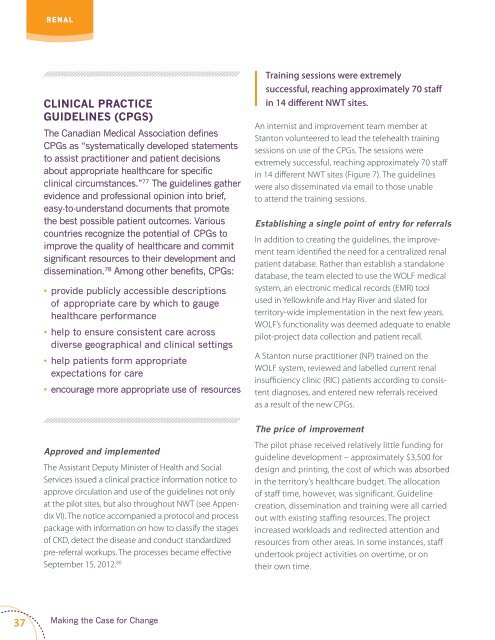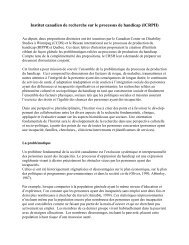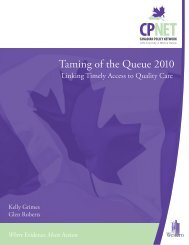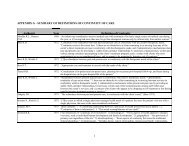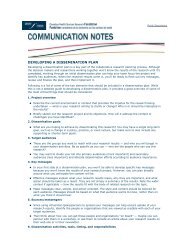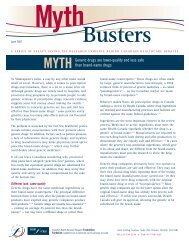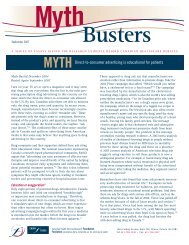Full Report
Full Report
Full Report
Create successful ePaper yourself
Turn your PDF publications into a flip-book with our unique Google optimized e-Paper software.
RENAL<br />
Clinical practice<br />
guidelines (CPGs)<br />
The Canadian Medical Association defines<br />
CPGs as “systematically developed statements<br />
to assist practitioner and patient decisions<br />
about appropriate healthcare for specific<br />
clinical circumstances.” 77 The guidelines gather<br />
evidence and professional opinion into brief,<br />
easy-to-understand documents that promote<br />
the best possible patient outcomes. Various<br />
countries recognize the potential of CPGs to<br />
improve the quality of healthcare and commit<br />
significant resources to their development and<br />
dissemination. 78 Among other benefits, CPGs:<br />
• provide publicly accessible descriptions<br />
of appropriate care by which to gauge<br />
healthcare performance<br />
• help to ensure consistent care across<br />
diverse geographical and clinical settings<br />
• help patients form appropriate<br />
expectations for care<br />
• encourage more appropriate use of resources<br />
Training sessions were extremely<br />
successful, reaching approximately 70 staff<br />
in 14 different NWT sites.<br />
An internist and improvement team member at<br />
Stanton volunteered to lead the telehealth training<br />
sessions on use of the CPGs. The sessions were<br />
extremely successful, reaching approximately 70 staff<br />
in 14 different NWT sites (Figure 7). The guidelines<br />
were also disseminated via email to those unable<br />
to attend the training sessions.<br />
Establishing a single point of entry for referrals<br />
In addition to creating the guidelines, the improvement<br />
team identified the need for a centralized renal<br />
patient database. Rather than establish a standalone<br />
database, the team elected to use the WOLF medical<br />
system, an electronic medical records (EMR) tool<br />
used in Yellowknife and Hay River and slated for<br />
territory-wide implementation in the next few years.<br />
WOLF’s functionality was deemed adequate to enable<br />
pilot-project data collection and patient recall.<br />
A Stanton nurse practitioner (NP) trained on the<br />
WOLF system, reviewed and labelled current renal<br />
insufficiency clinic (RIC) patients according to consistent<br />
diagnoses, and entered new referrals received<br />
as a result of the new CPGs.<br />
Approved and implemented<br />
The Assistant Deputy Minister of Health and Social<br />
Services issued a clinical practice information notice to<br />
approve circulation and use of the guidelines not only<br />
at the pilot sites, but also throughout NWT (see Appendix<br />
VI). The notice accompanied a protocol and process<br />
package with information on how to classify the stages<br />
of CKD, detect the disease and conduct standardized<br />
pre-referral workups. The processes became effective<br />
September 15, 2012. 80<br />
The price of improvement<br />
The pilot phase received relatively little funding for<br />
guideline development – approximately $3,500 for<br />
design and printing, the cost of which was absorbed<br />
in the territory’s healthcare budget. The allocation<br />
of staff time, however, was significant. Guideline<br />
creation, dissemination and training were all carried<br />
out with existing staffing resources. The project<br />
increased workloads and redirected attention and<br />
resources from other areas. In some instances, staff<br />
undertook project activities on overtime, or on<br />
their own time.<br />
37<br />
Making the Case for Change


